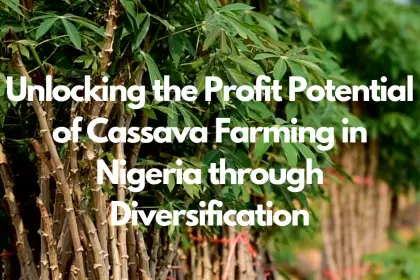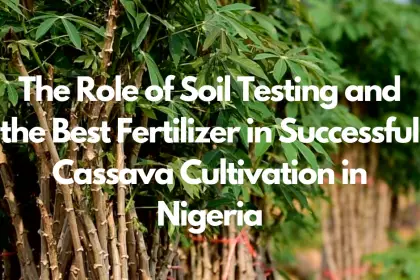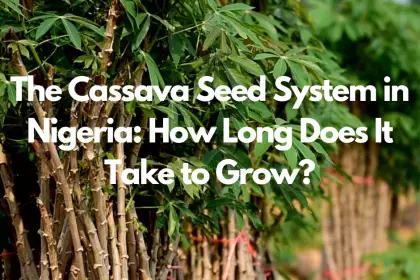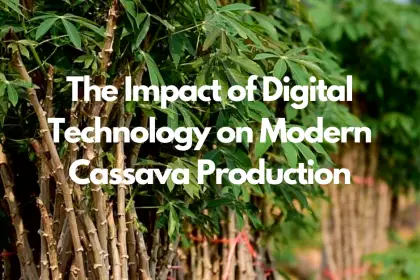In the rapidly evolving landscape of global agriculture, the importance of mechanization in modern cassava farming cannot be overstated. Mechanization covers a comprehensive array of operations, from land preparation, planting, and weeding to more niche areas such as fertilizer application, irrigation, and post-harvest processing. This technological leap promises not only to refine efficiency and productivity but also plays a critical role in addressing the value chain, enhancing resource management, and fostering rural development.
With the world grappling with food security and sustainable agricultural practices, mechanized cassava farming emerges as a crucial component in international development strategies. It offers tangible solutions to pressing challenges such as nutrient deficiencies in crops, optimizing the planting process, and significantly improving crop yields. This article delves into how mechanization is revolutionizing cassava farming, underscoring its benefits, and showcasing real-world successes that underscore its potential for transforming agriculture.
Challenges in Traditional Cassava Farming
In Nigeria, the heartland of cassava production, the process remains predominantly manual, particularly in states like Ogun, Oyo, and Ekiti. The National Centre for Agricultural Mechanization (NCAM) has highlighted a stark reality through its surveys – a glaring deficiency in mechanization across the board, from peeling to drying. This manual approach not only hampers efficiency but also significantly limits the scale of operations that can be managed.
- Manual Operations in Cassava Processing:
-
- Peeling, Washing, and Drying: Dominantly manual tasks with low mechanization levels.
- Impact: Reduced efficiency and scalability in cassava processing.
In contrast, Malaysia’s experience with cassava underscores a different set of challenges. Despite having established technologies for cassava cultivation, the contraction of cultivable land coupled with labor shortages has led to a decline in cassava acreage. This situation is mirrored in Cambodia, where despite the rapid adoption of agricultural mechanization, critical processes like seedling planting and tuber uprooting remain labor-intensive due to the physical nature of the crop and economic constraints such as the cost of hiring uprooting machines.
- Challenges in Cassava Cultivation:
-
- Malaysia: Decline in cultivation due to land and labor scarcity.
- Cambodia: Limited mechanization in seedling planting and tuber uprooting due to the cost implications and labor intensity of the crop.
The implications of these challenges are profound in Nigeria, the world’s leading cassava producer. Despite its status, over half of the cassava yield is lost to inefficiencies in production and processing. This loss is not just a matter of wasted produce but reflects broader systemic issues ranging from inadequate policies to the lack of a market-led strategy for agro-industrial development. The farmers’ plight is further exacerbated by limited access to mechanized tools, high input costs, and a lack of technical know-how, culminating in a scenario where the potential economic benefits of cassava production remain largely untapped.
- Systemic Challenges in Nigerian Cassava Farming:
-
- Production and Processing Inefficiencies: Leading to significant waste.
- Economic and Policy Issues: Inadequate macroeconomic and sector policies affecting agriculture.
- Barriers to Mechanization: High cost, limited availability, and knowledge of machines.
- Recommendations: Adoption of a market-led strategy emphasizing agro-industrial development and resource mobilization through partnerships.
The Role of Mechanization in Transforming Cassava Farming
Mechanization in cassava farming encompasses a wide array of operations, significantly impacting the efficiency and productivity of this crucial agricultural activity. With the advent of prototype machines, the landscape of cassava farming and processing has undergone a remarkable transformation. These innovations include:
- Cassava Farming Machines:
-
- Cassava planters
- Weeders
- Harvesters
- Cuttings meters
- Cassava Processing Equipment:
-
- Peelers
- Graters
- Gari-mash pulverizer/sifters
- Gari frying machines
The introduction of these machines has not only streamlined the farming process but has also led to a substantial increase in cassava yield. For instance, states like Ogun, Osun, and Kwara in Nigeria witnessed an increase in yield from 4-9 tonnes per hectare to an impressive 30 tonnes per hectare. This leap in productivity underscores the pivotal role of mechanization in enhancing cassava farming outcomes.
The benefits of mechanization extend beyond just increased yields; they also contribute to improved resource utilization and production efficiency. A study in Uganda revealed that farmers who embraced mechanized cassava farming experienced significant improvements in technical efficiency. Key factors contributing to this efficiency include:
- Planting cassava as a sole crop
- Accumulated farming experience
- Education and membership in farmer associations
- Access to markets and connections with cassava processors
Furthermore, the Cassava Mechanisation and Agro-processing Project (CAMAP) has been instrumental in revitalizing the cassava industry across Sub-Saharan Africa. By focusing on mechanized production and agro-processing along the cassava value chain, CAMAP aims to achieve several objectives:
- Increase cassava production: Leveraging mechanization to boost crop yields.
- Add value to the cassava industry: Through mechanized processing techniques.
- Economic viability: Building capacity among local entrepreneurs for sustainable mechanization services.
- Integration of digital solutions: Facilitating farmer aggregation for efficient mechanization services.
The project’s implementation in countries like Nigeria, Uganda, Zambia, and Tanzania has led to remarkable outcomes, including a 200% increase in yields, a 100% increase in incomes, and improved quality of life for participants. This initiative has also attracted more women and youth to consider cassava farming as a viable business venture, demonstrating the transformative potential of mechanization in the agricultural sector.
Benefits of Mechanized Cassava Farming
Mechanized cassava farming has ushered in a new era of agricultural productivity and efficiency, offering numerous benefits that significantly outpace traditional farming methods. Here’s a closer look at the advantages:
- Increased Yield and Profitability:
-
- Yield Increase: Mechanization has led to a dramatic rise in cassava yield, from 4-9 tons per hectare (ha) to an astounding 30 tons/ha for project beneficiaries. This increase is a testament to the efficiency of mechanized operations.
- Net Profit: The profitability of cassava farming has seen a substantial boost, with mechanized farming yielding a net profit of 482,000 Naira/ha, compared to just 78,000 Naira/ha for traditional methods. This stark difference underscores the economic viability of adopting mechanized practices.
- Cost and Labor Efficiency:
-
- Reduction in Planting Costs: The adoption of mechanized planting has slashed planting costs by 51%, making it a more cost-effective option.
- Labor and Harvest Cost Reduction: Mechanical harvesters have reduced labor costs by 53%, and the overall cost of harvest by 43%, contributing to a 12% reduction in total production costs. This efficiency is further exemplified by the two-row cassava planter (Model PC-20) and three-row cassava planter (Model PMT-3), which require minimal human labor, thus streamlining the planting process.
- Quality and Scale:
-
- Uniformity and Quality: The two-row cassava planter has achieved a uniformity in spacing of around 92%, compared to the three-row planter’s 80%, indicating a higher precision that contributes to better crop quality.
- Scalability: Mechanized planting and harvesting not only enhance the quality of the cassava produced but also allow for operations on a larger scale, aiming for a minimum yield of 25 tons per hectare. This scalability is vital for meeting the increasing demands for cassava and its derivatives.
The Cassava Mechanisation and Agro-processing Project (CAMAP) further illustrates the transformative impact of mechanization on cassava farming. Through CAMAP, farmers, processors, and marketers in countries like Nigeria, Uganda, Zambia, and Tanzania have witnessed a 200% increase in yields and a 100% increase in incomes, thereby improving food security and livelihoods. This initiative has also played a crucial role in attracting more women and youth to cassava farming, highlighting the broader social benefits of mechanization. By promoting the use of improved stem varieties, fertilizers, herbicides, and timely farm operations, CAMAP has enhanced the efficiency and quality of cassava production, setting a benchmark for the future of mechanized agriculture.
Case Studies and Success Stories
In the journey towards revolutionizing cassava farming through mechanization, certain states in Nigeria have made notable strides while also highlighting areas needing urgent intervention. Here’s a closer look at the case studies from Ogun, Oyo, and Ekiti States:
- Ogun State: A Blend of Manual and Mechanical Processing
-
- Mechanical Processing Contribution: 31.39% of cassava processing operations, specifically in grating, dewatering, drying, and milling.
- Manual Processing Prevalence: 58.19% of operations were manually conducted.
- Actionable Insight: There’s a pronounced need to increase the number of cassava processing machines to elevate processing operations.
- Oyo State: Urgent Need for Mechanization
-
- Critical Operations Needing Attention: Cassava peeling, washing, grating, dewatering, and milling.
- Manual Processing Prevalence: 65.20% of operations were manually conducted.
- Government Intervention: It’s recommended that the State government encourages cassava processors through loan facilities for procuring necessary machines to boost processing operations.
- Ekiti State: Encouraging Mechanization through Financial Support
-
- Manual Processing Prevalence: 68.96% of operations were manually conducted, indicating a significant reliance on manual labor.
- Recommended Action: The State government is advised to assist cassava processors with loan facilities to acquire necessary processing machines, aiming to enhance cassava processing operations within the state.
These insights not only underscore the varying degrees of mechanization across different states but also pinpoint specific areas where intervention could lead to substantial improvements in cassava processing operations. The emphasis on government support through loan facilities highlights a practical approach to overcoming financial barriers to mechanization, thereby paving the way for enhanced productivity and efficiency in cassava farming.
Conclusion and Future Outlook
Through the exploration of mechanization’s transformative impact on cassava farming, we’ve delved into its pivotal role in enhancing efficiency, optimizing resource management, and significantly improving yields. The vivid illustrations from Nigeria, Malaysia, Cambodia, and Sub-Saharan Africa offer compelling evidence that mechanization is not just a technological advancement but a critical leverage point for addressing food security, economic viability, and sustainable agricultural development. The discourse underscored mechanization’s capacity to revolutionize cassava farming, from field preparation to post-harvest processing, illustrating a clear trajectory towards more productive, efficient, and sustainable agricultural practices.
As we reflect on the journeys of Ogun, Oyo, and Ekiti states in Nigeria alongside the broader impacts in Sub-Saharan Africa, it’s evident that the path to revolutionizing agriculture through mechanization is both necessary and attainable. The call for increased government support, financial assistance for farmers, and the broader implementation of mechanical solutions is imperative. Mechanization presents a beacon of hope for not only elevating cassava production to its highest echelons but also for reinforcing the agricultural sector’s role in economic development and sustainability. It heralds a promising future for addressing the multifaceted challenges of modern agriculture, marking a significant step towards the realization of global food security and agricultural prosperity.
FAQs
What are the key concepts associated with the Agricultural Revolution?
The three pivotal concepts that were integral to the Agricultural Revolution, a period of significant increase in agricultural productivity in Britain from the mid-17th to late 19th centuries, include crop rotation, selective breeding, and enhanced utilization of arable land.
How does mechanization contribute to farming?
Mechanization plays a crucial role in farming by ensuring that the timing of agricultural activities meets the optimal agronomic or business requirements. It enables more efficient use of resources such as water, seeds, pesticides, and fertilizers, while also reducing spoilage and harvest losses, leading to lower overall costs.
What impact has mechanization had on agriculture in Nigeria?
In Nigeria, the introduction of agricultural mechanization has led to significant benefits, including an increase in the amount of land cultivated, improvements in crop yields, and a rise in farmers’ incomes, with average increases of 2.34, 1.07, and 1.44 in each respective category.
What are considered best practices for farming cassava?
For cassava farming, best practices involve minimizing conventional tillage, which includes ploughing, harrowing, or hoeing the land before and during crop growth. Instead, farmers are encouraged to adopt conservation tillage, which avoids soil inversion and the burying of crop residues, promoting a more sustainable approach to land management.











